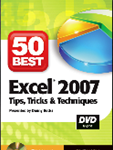MS Excel’s =IF() Function is a very versatile function and it is used in a variety of situations. Watch this short video lesson to learn how to use it when Grading Scores, Calculating Shipping Rates and “Trapping Errors.”
Here are the steps to follow in this lesson:
- The =IF() Function requires three arguments: A “Logical Test” – (which will return either a TRUE of a FALSE Response); the Value if “True,” and the Value if “False.”
- In my first example I have set up a simple scoring system for grades. For the Value if TRUE, I have entered “Pass.” Notice that the TEXT must be enclosed in ” “.
- In my second example, I have “nested” several =IF() functions inside the Value if FALSE Function Argument. You can “nest” up to 7 different IF() Functions in a formula.
- Notice how useful the =IF() Function is when you want to “trap an error.” Especially when you are starting to build a spreadsheet and many cells contain Zeros or NULL Values.


